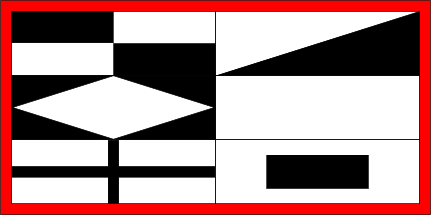
by Audrius Slapsinskas, 4 July 2003

Last modified: 2003-08-09 by dov gutterman
Keywords: lithuania | neringa | klaipeda |
Links: FOTW homepage |
search |
disclaimer and copyright |
write us |
mirrors

by Audrius Slapsinskas, 4 July 2003
See also:
The flag and the coat of arms of Neringa city (Klaipeda county
- Klaipedos apskritis). The flag is drawn by me according to
picture from official site of Neringa municipality (<www.neringainfo.lt>).
The coat of arms I drew according to the picture from the book:
The Heraldry of Lithuania.
Audrius Slapsinskas, 4 July 2003
According to <www.neringainfo.lt>,
the five bi-coloured fields are modelled after the traditional
weathercocks (sic) of the fishing boats of the villages, and the
white field symbolises the villages buried under the sand.
Translated from <www.memelland-adm.de>:
"On 26 June 1844, an administrative decision was announced.
This is the birthday of the 'Kurenwimpel'. It was decided that
all sailing boats on the Kurische Haff should carry a pennant
from the top of the mast. The pennant should be at least 2 feet
long and one foot wide. The colours and pattern of the pennant
were prescribed for each village by the Haff...... The first
pennants were made of canvas in a wooden frame, later versions
were made of wooden boards or metal plate, rotating on its
axis."
Ole Andersen, 22 July 2003
kl-ne.gif)
by Audrius Slapsinskas, 4 July 2003
From <www.neringainfo.lt>:
"The shield of the coat of arms of Neringa is divided into
six black and silver (white) fields. Rectangular fields symbolize
Nida, triangles symbolize Preila, a rhombus symbolizes Purvyne of
Nida, the silver field symbolizes Karvaiciai and other villages
buried under sand, a cross stands for Juodkrante and a rectangle
symbolizes weathervanes of historical fishing boats -kurenai -
used by fishers of Pervalka villages. At the bottom of the
shield, against the blue backdrop there is a silver letter
"N", which symbolizes the city of Neringa. The city was
founded in 1961. Artist Arunas Tarabilda created the coat of arms
of Neringa City in 1967 - 1968.
It pictured the fishing boats, called kurenai, of the villages of
the Curonian Spit as well as weathervanes, which were established
in the middle of the 19th century by the Rusne Lagoon inspection.
When preparing a new design of the coat of arms for Neringa, it
was noticed that the details were not very accurate in the coat
of arms of 1968. The village of Rasyte , which symbol was present
in the coat of arms, in fact, belongs to the Russian Federation
at present, and the weathervanes of Juodkrante contained only a
cross in former times. Therefore, at the request of the
inhabitants of Neringa City, the symbol of Rasyte in the new coat
of arms was replaced with an empty silver background to symbolize
Karvaiciai and 16 other former villages in Neringa territory
buried under the sand. Taking into consideration the importance
of Nida as the administrative center of Neringa city as well as
the aesthetic aspect of the design of the coat of arms, it was
decided that the black and silver fields in the shield should be
arranged in the following order: the top left field symbolizes
Nida, the field below - Purvyne of Nida and the bottom one
pictures the weathervanes of fishing boats, Kurenai, of
Juodkrante. The top rectangle on the right symbolizes Preila, the
empty field below pictures Karvaiciai and other villages buried
beneath the sand and the bottom one stands for Pervalka.
The coat of arms of Neringa city created by Tarabilda was
corrected by
architect Ricardas Kristapavicius. The Heraldry Commission of
Lithuania approved the coat of arms of Neringa on January 23,
1997. The President of the Republic of Lithuania confirmed it on
February 18, 1997 (Decree No.1209).
Neringa city flag also pictures the coat of arms of Neringa.
White (silver) and black are the domineering colors of the
flag."
Ole Andersen, 22 July 2003